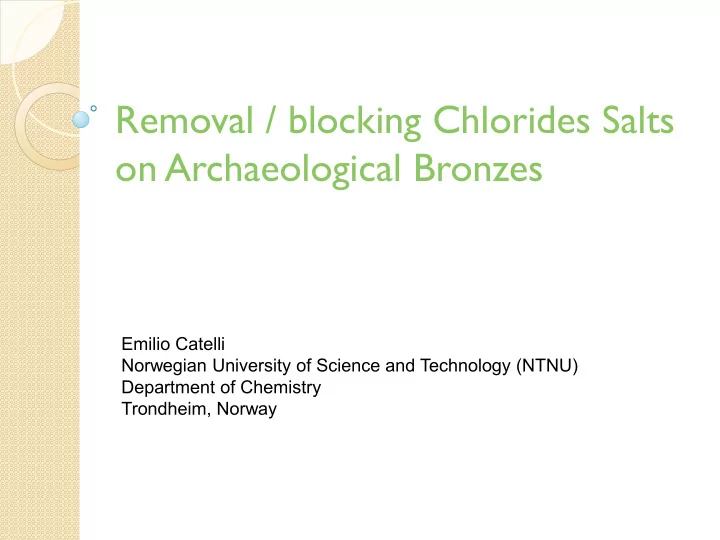

Removal / blocking Chlorides Salts on Archaeological Bronzes Emilio Catelli Norwegian University of Science and Technology (NTNU) Department of Chemistry Trondheim, Norway
Background Bronze disease Bronze disease : a progressive deterioration/corrosion of copper alloys caused by formation of cuprous chloride in presence of oxygen and moisture: Anodic reaction: Cu (s) = Cu + + e - Cathodic reaction: ½ O 2 + H 2 O + 2e - = 2OH - Cu + + Cl - = CuCl(s) (1) 4CuCl + O 2 +4H 2 O = 2Cu 2 (OH) 3 Cl +2H + +2Cl - Δ G= -360.9 KJ/mol (2)
Background archaeological patina Cuprite : Cu 2 O Nantochite : CuCl Malachite : CuCO 3 • Cu(OH) 2 Azurite : 2CuCO 3 • Cu(OH) 2 Ground Bronze Alloy
Background archaeological patina 4CuCl + O 2 +4H 2 O = 2Cu 2 (OH) 3 Cl +2H + +2Cl - (2) formation of copper hydroxychlorides isomers atacamite, paratacamite and botallackite Cuprite : Cu 2 O Nantokite : CuCl Malachite : CuCO 3 • Cu(OH) 2 Azurite : 2CuCO 3 • Cu(OH) 2 Ground Atacamite : Cu 2 (OH) 3 Cl Paratacamite : Cu 2 (OH) 3 Cl Botallackite : Cu 2 (OH) 3 Cl Bronze Alloy Mazzeo R., Patine su manufatti metallici, Le patine: genesi, significato e conservazione , KermesQuaderni Nardini Editore, 2005, pp.29-43
Background Copper hydroxychlorides Name Color Chemical formula Crystalline structure Nantokite pale green CuCl Cubic Atacamite vitreous green Cu 2 (OH) 3 Cl Orthorombic Paratacamite pale green Cu 2 (OH) 3 Cl Rhombohedral Botallackite pale bluish- Cu 2 (OH) 3 Cl Monoclinic green clinoatacamite pale green Cu 2 (OH) 3 Cl Monoclinic Anarkite Light green (CuZn 2 ) 2 (OH) 3 Cl Rhombohedral
Bronze disease: Why dangerous? Expand in volume on conversion to one of the copper trihydroxychlorides (cracking and fragmentation) Can reduce an apparently solid object into a heap of light green powder
Restoration steps of a bronze object 1. Disassembly 2. Cleaning 3. Washing treatments 4. Stabilization 5. Consolidation 6. Reassembly 7. Filling lacunae 8. New support 9. Protection
Removal or blocking Chlorides salts Cleaning reagents a. Rochelle salt Cu 2 (OH) 2 Cl 2 +2NaOH +2C 4 H 6 O 6 2 C 4 H 5 O 6 Cu +2NaOH + 4H 2 O b. Glyceryn or alkaline glycerol Cu 2 (OH) 2 Cl 2 +2C 3 H 8 O 3 2C 3 H 6 O 3 Cu +2H 2 O +2HCl
Removal or blocking Chlorides salts Stabilization techniques a. Chemical methods 1. Thouvenin method 2. Organ method (1961) 3. Sodium sesquicarbonate (1921) 4. Benzotriazole (BTA) 5. Sodium dithionite (1987) b. Electrochemical/electrolytic methods 8. Rosemberg Method (1920-1970) 9. Na sesquicarbonate (1948)
1.Thouvenin Method Treatment for diffuse corrosion The treatment require the use of two solutions: A. Complexing solution CuCl 2 + 4NH 3 • H 2 O → Cu(NH 3 ) 4 Cl 2 + 4 H 2 O blue color B. Precipitating solutions
2. Organ method Treatment for small corroded areas Paste of Ag 2 O in EtOH into the corrosion pit Ag 2 O + 2CuCl = 2AgCl + Cu 2 O
3.Na sesquicarbonate NaHCO 3 • Na 2 CO 3 (equimolar mixture ) 5% solution in distilled water (pH10 ) CO 3 2- + H 2 O = HCO 3 - + OH - 2CuCl + OH - =Cu 2 O + 2HCl 2HCl + Na 2 CO 3 = NaCl + H 2 O + CO 2 Drawback: 1. mineralogical changes of the patina Cu 2 O +H 2 CO 3 + H 2 O = CuCO 3 • Cu(OH) 2 +H 2 2. formation of chalconatronite(green/blue) Na 2 Cu(CO 3 ) 2 •3H 2 O due to high conc of Na sesquicarbonate
4.Benzotriazole (BTA) Benzotriazole (BTA) commonly used as an inhibitor 1% BTA solution in deionized water or 3-5% BTA in ethyl alcohol When BTA reacts with cupric chloride, a cupric BTA derivative precipitates from solution; It has been assigned the formula Cu(BTA)Cl
5.Sodium dithionite 3Cu 2 (OH) 3 Cl + S 2 O 4 2- + OH - = 6[Cu(OH)] + 3Cl - + 4H + + 2SO 4 2- 6Cu(OH) + S 2 O 4 2- = 6Cu + 2SO 4 2- + 2H 2 O +2H + 3Cu 2 O + S 2 O 4 2- + OH - = 6Cu + 2SO 4 2- + H +
8. Electrochemical method Rosenberg method (galvanic cell method) 3CuCl + Al = 3Cu + AlCl 3 The object is wrapped in aluminum foil and exposed to high humidity (>90% RH) A gel poultice of Agar-Agar water and glycerol is used as electrical connection between bronze and foil.
9.Electrolytic method The artifact is the cathode A mild steel electrode is the anode 5 % sodium sesquicarbonate can be used for the electrolyte Applied potential difference: 0.10 V Current density should not be allowed to fall below 0.02 A/cm 2 Cathodic reaction: Cu 2+ +2e - = Cu Secondary cathode reaction 2H 2 O + 2e - = H 2 + 2 OH - Anodic reaction: 4OH - = O 2 + 2H 2 O + 4 e -
References Schott D., Bronze and copper in Art, Getty publication , 2002 Schott D., JAIC 29(1990): 193-206 Oddy W.A. and Hughes M.J., Studies in Conservation, 15 (1970):183-189 Angelucci S et al, Studies in Conservation 23 (1978):147-156 Sease C, Studies in Conservation, 23 (1978):76-85 Organ R.M, Studies in Conservation (1962) Macleod D. I., Studies in Conservation, 32(1978): 25-40 Mazzeo R., KermesQuaderni Nardini Editore, 2005, pp.29-43
Thank you for your attention
Recommend
More recommend